KVH V3-IP Broadband & Thuraya SatSleeve
Since leaving Myrtle Beach on April 1, I’ve spent a fairly ridiculous amount of time messing around with WiFi and cellular Internet connections, and not only is Gizmo quite well equipped in those categories but she’s stayed within a mostly first world country (just kidding, North Carolina). Admittedly my thirst for connectivity is high, but I might trade a small body part for a system that simply put me online 24/7/wherever. That’s the promise of KVH’s latest TracPhone mini-VSAT V3-IP, and ‘simply’ is the key word. KVH has for a while offered high-speed, ‘reasonably’ priced satellite Internet with a 17.6-inch high V3 dome antenna that can purportedly work on boats as small as 30-feet. What’s new here is the unified antenna controller and modem known as the CommBox (above), which not only looks simple but can even be installed out of sight because as the “ip” in the product name suggests, you can check into this system with most any browser on a PC or tablet connected to the CommBox by Ethernet or WiFi…
A few years ago KVH acquired Virtek Communications AS, a small Norwegian developer which had apparently made great strides at the complex issue of managing multiple satellite and other communications systems on ships. Many of those possibilities are available as add-ons to even the little V3-IP — like using an Iridium Pilot system (tested on Panbo as OpenPort) for backup and global coverage (take that, Inmarsat!) or getting hooked in to your company’s Virtual Private Network (VPN)…
But what looked especially attractive to me is that main CommBox control screen above, which you can pull up on your iPad or the yacht’s computer. An iPad browser is how I normally manage Gizmo’s Rogue Wave Pro high power WiFi system (detailed here), mainly because it’s quick and easy and one of the first things I like to do when I arrive somewhere is to see if there’s decent WiFi available. Unfortunately, as good as the Rogue is — seeing some 50 hotspots in the residential creek I’m anchored in this morning — there often isn’t an open one, also like this morning. Now it happens that there’s good Verizon LTE coverage in this creek, so I’m watching live video of the America’s Cup in Naples while I write, but that’s not been common, even with the help of the Wilson cell amp.
At any rate, I certainly get why I see so many KVH TracPhone and TracVision antennas on higher-end boats. The V3-IP is not inexpensive at $16,995 for the hardware package with a minimum annual service contract of $50/month for just 50 megabytes. But, then again, you can change service plans freely and KVH even has tips on how to minmize costs, all found among its remarkably thorough and well-written customer documents. How much is simple connectivity worth to you?
And where will it all go? A really interesting recent development is the Thuraya SatSleeve, which is a sort of iPhone case that along with an app switches the phone’s cellular service to Thuraya’s satellite system. Thuraya doesn’t cover the Americas and data is not yet enabled, but the attraction of using your own phone with its contacts, weather apps, whatever is obvious. Will Iridium or Globalstar do something like this?


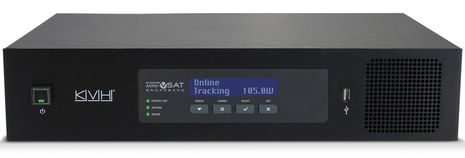
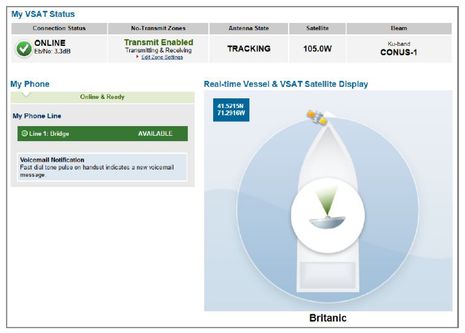
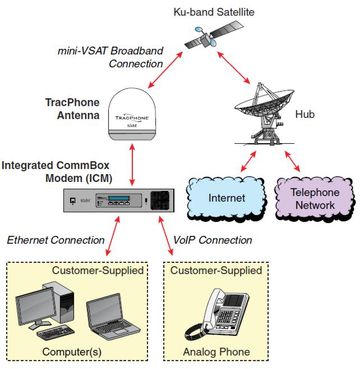

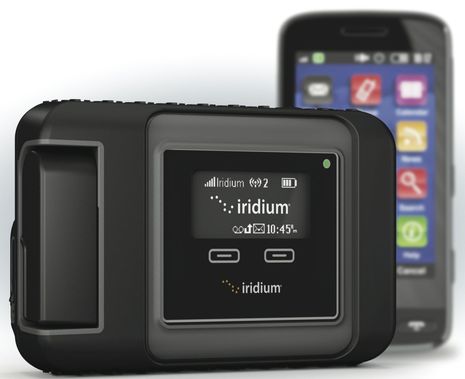

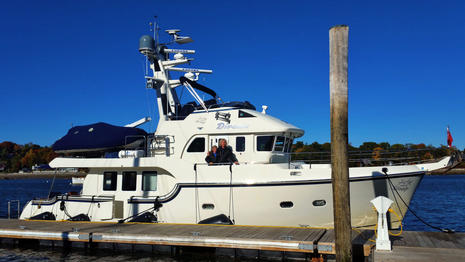








Aboard Distant Shores II we are big proponents of the Huawei Mifi type solution – online through Cellular Data plans bought in the country. We have done this for the last 3 years in (so far 16 countries). On arrival in a new country we pop into a phone store and buy a data sim (usually $5) plus a plan for data – typical $20-$40 for 2-5GB of data. Thats almost 100 times the 50 MB from your $16,995 package, and the Huawei is less than $100. It would work for your whole cruise down the US coast!
Cheers
Paul Shard
SV Distant Shores II
http://www.distantshores.ca
Hi Paul,
You’re absolutely right that local cell phone or wifi will always be the most economical way to connect to the internet.
The TracPhone V3-IP and our mini-VSAT Broadband service are more for people who want to connect offshore (line of site for most cell phone/wireless transmissions is usually about 15 miles from the tower) or in remote areas or countries where they can’t easily sign up for the local cell services (roaming on foreign cell services often costs $20-25 per megabyte!).
Most voyagers used to use Inmarsat satellite services when they weren’t able to get local services. The FleetBroadband 150 is $7,500, which is considered “low price” for satellite communications hardware. The problem is that Inmarsat has raised the prices of their service to ridiculous levels. An entry level package with only 10MBs of service per month is now over $200, and each additional megabyte will cost you another $24. If you use as little as 1MB per day your monthly airtime costs skyrocket quickly to about $700.
What we’ve done to offer our customers a better solution is to set up our own global network that can be accessed by, in maritime VSAT terms, are considered very small and very affordable onboard equipment (comparative mnaritime VSAT systems are 85% larger and 3 times the price).
Our hardware price which retails at $16,995 as Ben points out, is more than double a FleetBroadband 150 system at $7,500 and incrementally higher than a FleetBroadband 250 which goes for about $12,500. But our airtime packages start at $49 for 50MBs of service — less than 1/10th of the price of Inmarsat service. For people who actually need to connect offshore or in remote locations, we offer tremendously lower lifetime costs (hardware plus airtime) than any other solution on the market.
I know there is sticker shock on this stuff, but if you really use satellite communications onboard and you compare the costs involved, the value quickly becomes pretty clear.
The full mini-VSAT Broadband story is available at http://www.minivsat.com if anybody is interested, or call your local NMEA technical dealer and discuss the options. The TracPhone V3 won their award in 2012 for communications products.
Hi Jim,
We have crossed the Atlantic 5 times but our only experience with Satphones has been the ISatPhonePro which we used last November. Quite poor for data connection and I doubt we managed 1 MB total during the entire crossing.
I can see how someone who was moving between islands more or spent more time on passages might appreciate your system. But they would probably still need a cellular system for day to day use…
Many voyagers we know are still using a modem with an SSB.
While prices are high we will probably continue our cellular data strategy and just be out of touch during crossings.
Thanks Paul,
We’re not trying compete with your cell phone or your SSB. In fact, one of board members Stan Honey was a founder of the popular SailMail service for sending radio over SSB. There are definite tradeoffs where one technology outweighs the other, and we fully acknowledge that it’s hard to beat the low cost of cell phone or SSB.
Here’s a blog post on a KVH customer that did find value in the TracPhone V3 for his Atlantic crosssing and extended voyaging, just to give everybody an idea of what can be done with our gear:
http://www.kvhmobileworld.kvh.com/kvh-marine-vsat-lets-transatlantic-sailor-stay-connected-to-kids/
Best regards,
Jim
Thanks Jim,
Thats a GREAT example. We were actually only a few miles away from Arbella on the ARC 2012 and were not able to get almost any internet access. We were lucky to get an email to go through. Amazing they were on facetime!! That would really change a passage.
Thanks for the link.
Paul
Did the most recent article posted here mysteriously disappear? I can’t even recall the product brand, as it was unfamiliar to me…MFD 3/8″ thick with a feature set (including Linux operating system) that would gag a python. I got up to use the bathroom, and the article was gone when I got back…and it’s still gone.
I think an explanation is due, Ben. It almost read like an April 1st hoax…I was just waiting to scroll-down to see projected price, when “nature called”. Then, it was gone. WTF?
Perhaps something you were not authorized to release, then you had to turn-back the clock? Once cat is out of bag, hard to get back in…(old Danish proverb)…
Or, is it just the drugs I’m on following a broken lumbar spine and I just imagined all of this?
I think you may have been looking at The Marine Installers Rant. Bill is describing his fantasy MFD in the hope that someone will build it.
http://themarineinstallersrant.blogspot.co.uk/2013/04/the-celestronic-m3-perfect-chart-plotter.html
Good detective work, Fishwife!
And be careful, Karl; The Marine Installers Rant is an especially dangerous read for someone already under the influence.
Great post Ben,
The only thing that may be worth mentioning is that the Mini V-Sat service is not global, which is too bad for us folks that cruise in the South Pacific ocean.
Take a look at the KVH coverage map to see the massive hole in the South Pacific: http://www.kvh.com/Pages/Satellite-Coverage-Maps/Satellite-Coverage-Maps/TracPhone-Maps/miniVSAT-Broadband.aspx
I recently purchased a FleetBroadband Sailor 150 system that uses the Inmarsat network and provides worldwide coverage (outside the polar regions). I would have gone with mini-vsat for all the reasons you suggest, but it seems to be aimed at coastal cruisers, not ocean sailors. Hopefully that will change in the future?
Regards,
Doug
http://zangeziatlarge.com
Thanks, Doug!
You are right about the mini-VSAT hole in the South Pacific — it’s a huge area with few sat comm users — but it is possible to augment the V3-IP with an integrated Iridium Pilot system that is truly global (even the poles).
I really enjoyed browsing your blog. The piece on troubleshooting your generator is amazing. Thanks for sharing.
Hi Doug,
You bring up a valid point about the South Pacific coverage, but to call our Ku band network coastal when we’ve got the entire northern hemisphere and areas around all the continents and much of the Indian Ocean region covered isn’t really fair. As Ben mentions, we have an Iridium backup solution that integrated with the mini-VSAT service for “pole to pole” coverage. As important, for larger vessels (probably 80′ and up), we also have a 1 meter dual mode C and Ku band antenna that works both with our Ku band service and our global C-band overlay to provide coverage matching FleetBroadband.
The FB150 is a great product concept. I worked closely with the guys at Inmarsat to help bring this product to the yachting market and was the main promoter of the service in this market when it was launched. The only problem with the product is that Inmarsat couldn’t get away from their high margin commercial business and had a difficult time offering attractive airtime packages.
Over the past two years most of the people I knew at Inmarsat have left the company, and the new management has pretty much written off any customer that isn’t willing to spend $1,500 per month on service, a price point you hit if you use as little as 2-3 megabytes of data a day. At this point, good as FleetBroadband is, the prices become ridiculous.
The good news is that there are A LOT of new satellites being launched, which we will take advantage of as soon as it becomes available. The satellite service market is only going to get better from here on out. Competition and new services are great news for consumers.
Best regards,
Jim
Hi Jim,
Sorry about the blanket coastal statement. I was referring to South Pacific coverage, where the coastal areas and much of Asia are well covered but the remote South Pacific cruising areas – Marquesas, Tahiti, Cook Islands, Boro Bora, Fiji, Samoa, Tonga and the stretch along the equator between the Caroline Islands and the Line islands south of Hawaii are not covered.
The FB150 pricing plans are ridiculous for sure, so I did a lot of research into the mini-vsat / Iridium hybrid system you described. In the end, I couldn’t justify installing two systems, when 90% of my needs would require the use of Iridium. In comparing Iridium with Inmarsat, my research indicated that both systems were very good, but the voice quality and reliability of Inmarsat is a bit better. I have confirmed this now I have my FB150 system installed as it replaced an Iridium SC4000 sat phone and the voice quality on the FB150 is certainly much better than my previous system, although this could be due to the age of my previous Thrane and Thrane Iridium terminal.
I’m hoping that increased competition will drive down the cost of FleetBroadband, but that might take a while. I am paying $699/month for 200 megabytes of data and 29 cents per minute for worldwide phone service. Additional megabytes are $3.30. Certainly not cheap!
Regards,
Doug
KVH just shipped its 5,000th TracPhone mini VSAT system and claims VSAT market dominance: http://goo.gl/Bifp2Y
Note that KVH provides the mini VSAT service too, and keeps adding features like MultiCast: http://goo.gl/HULfMP
So it’s altogether quite an accomplishment for a company that once just sold hardware for other satellite services and started with a family digital compass project:
http://www.kvh.com/About-Us/Company-History.aspx
Thanks Ben,
Much appreciated. It’s been fun working with you over the years and we really appreciate the wonderful job you do bringing news about electronics to the boating community. You’ve made a big difference in the editorial quality of several of the industry’s leading publishers!
Best regards,
Jim
Well, thanks, Jim; that makes us a mutual admiration society. I sometimes tell the story about how a wise industry veteran with a strong interest in new media took me aside at a wild Miami Boat Show party in about 2003 and encouraged me to become an independent online voice. I like to joke that “Blogging” was uttered much like “Plastics” in the movie The Graduates, except that your advice was right on target, made a difference when the Panbo opportunity came along, and I’m still appreciative. I also know that you continue to volunteer wise counsel to BWI and NMEA, and occasionally put a little heat under sloppy technical writing. Many thanks!
https://www.youtube.com/watch?v=PSxihhBzCjk